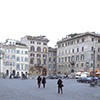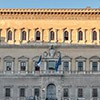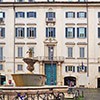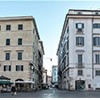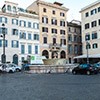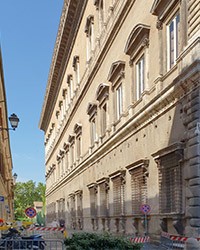
Piazza Farnese

Piazza Farnese and Palazzo Farnese, Giuseppe Vasi, 18th century, pic.Wikipedia

Facade of Palazzo Farnese in Piazza Farnese

Palazzo Farnese, piano nobile, fragment

Palazzo Farnese, piano nobile, fragment

Palazzo Farnese, piano nobile, fragment

Palazzo Farnese

Piazza Farnese, facade of the Church of Santa Brigida

Piazza Farnese, fountain, Palazzo Fusconi Pighini Del Gallo in the background

Piazza Farnese, staircase of the Fusconi Pighini Del Gallo Palace

Piazza Farnese, staircase of the Fusconi Pighini Del Gallo Palace

Piazza Farnese, staircase of the Fusconi Pighini Del Gallo Palace

Piazza Farnese, fountain, in the background the facade of the Church of Santa Brigida

Piazza Farnese, fountain, in the background the facade of the Palazzo Fusconi Pighini Del Gallo (on the left)

Piazza Farnese, via dei Baullari, on the right the palace Fusconi Pighini Del Gallo

Piazza Farnese, fountain, in the background the Fusconi Pighini Del Gallo Palace

Piazza Farnese during the carnival, Paolo Panini, pic.Wikipedia

Piazza Farnese, Palazzo Mandosi-Mignanelli, pic. Wikipedia

Piazza Farnese, on the left the facade of the Church of Santa Brigida
If we become tired of the hustle and bustle of the nightlife at Campo de’Fiori and would like to be transported to a whole different world, it is simply enough to turn into the via dei Baullari, adjacent to the square, and after several meters find ourselves in a magical place. We will exchange the noise for silence, entering an empty, spacious square, and find ourselves facing a façade of one of the most beautiful palaces in Rome – Palazzo Farnese. From afar we will be attracted by its illuminated (most of the time) windows, especially in the very middle, which hide the fresco-decorated study of the French ambassador. Without a doubt, we will be shocked by this beauty and most likely return during the day.
If we become tired of the hustle and bustle of the nightlife at Campo de’Fiori and would like to be transported to a whole different world, it is simply enough to turn into the via dei Baullari, adjacent to the square, and after several meters find ourselves in a magical place. We will exchange the noise for silence, entering an empty, spacious square, and find ourselves facing a façade of one of the most beautiful palaces in Rome – Palazzo Farnese. From afar we will be attracted by its illuminated (most of the time) windows, especially in the very middle, which hide the fresco-decorated study of the French ambassador. Without a doubt, we will be shocked by this beauty and most likely return during the day.
In the light of day, we will be able to see other elements of the square, although our eyes will still be drawn to the body of the dignified palace, whose construction included the most outstanding architects of the XVI century, for example, Michelangelo. Of course, the square was named in honor of the Farnese family, for whose greatness, the foundation was laid by Pope Paul III, not without the help of his sister Giulia Farnese
and her exceptional beauty as well as amorous skills. As we have already said, at present the palace houses the French Embassy, which explains the reason for the armed soldiers guarding its entrance.

The fame and significance of the Farneses have long since passed, but the square remained, as had all the arrangements around it, arranged thus in order to properly show off the body of the monumental residence. To accomplish this, the houses found in front of it were demolished, and in the XVI century (1545) the area was paved. Initially, corrida tournaments and festivals were held at the square and it was even flooded during the hot summer days before this custom was moved to another square – Piazza Navona. In time two identical fountains were placed on it, whose imposing bowls were taken out of the ancient Baths of Caracalla. The lilies which finish them off – the symbol of the Farnese family, and an element of their coat of arms, can also be seen on the palace elevation (six lilies).
When we have had our fill of the beauty of the residence and the fountains, and we take a look around, we will notice on the right, a modest, inserted among other façades Church of Santa Brigida – the national church of the Swedes. The monastery next to which it stands belongs to the Order of the Bridgettines. It was established by St. Bridget, who had resided within its walls and died there and experienced revelations (1373). For centuries the monastery hosted and helped pilgrims coming from Sweden and Scotland. Today in the former monastery the Bridgettines run a lodging house (Casa di Santa Brigida), which also houses a chapel and a room commemorating the patron saint, but also a large viewing deck from which both the square and the palace can be admired. The church was thoroughly reconstructed in the XVIII, which is testified to by its Classicist façade, decorated with beautiful statues of saints Bridget and Catherine of Sweden. The bell tower visible from afar is to remind us of the Roman roots of the building, but it was not built until the XIX century.

Across from Palazzo Farnese at the exit from via Baullari there is a free-standing simple in its form building with columns flanking its entry gate – Palazzo del Gallo di Roccagiovine, also known as Palazzo Fusconi Pighini Del Gallo. This structure, erected by Baldassarre Peruzzi (1520) as a Renaissance palace, often changed owners and underwent numerous modernizations. In the twenties of the XVIII century, it came into the possession of the Pighini family which modernized it in the style that is visible today; the author of this reconstruction concept was Alessandro Specchi. Above the architrave of the balcony door, we can see a cartouche with two coats of arms – the Gallo family (with a rooster) and Napoleon Bonaparte (with an eagle), being a souvenir of a marriage between representatives of both families in the XIX century. The thing we will not see from the square is the magnificent staircase with a double row of stairs stretching through three floors and found on one of the sides of a small, interior courtyard of the palace. Those fortunate enough to see it have to somehow find their way through the palace gate (which is usually closed).
This is not the only old palace found in the square. All of them (modernized multiple times) were built at the turn of the XVI and XVII centuries. One of them bordering the Vicolo dei Venti is distinguished by its size. The Palazzo Mandosi Mignanelli, since that is its name, is the property of one of the many aristocratic Roman families. It has a simple façade, created in the XVII century that is enriched only by four rows of stone siding.

At the corners of the square, where it meets the via del Mascherone, via dei Baullari, and via dei Farnesi, it is worth turning our attention to the so-called Madonnelles – cartouches with the images of the Madonna and Child. We can find many of these in Rome, but here we can admire Our Lady which is so venerated by the Roman populace in three different versions.




















